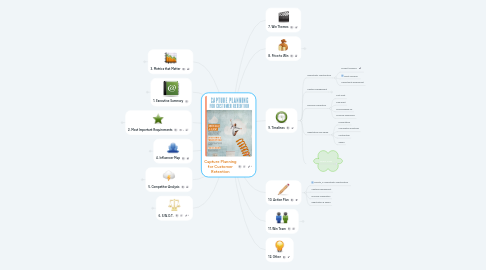
1. 3. Metrics that Matter
1.1. Cycle Time of Purchase Order
1.2. % of invoices disputed
1.3. % of construction waste recycled
1.4. Actual construction time
2. 1. Executive Summary
2.1. Client profile
2.2. History and past performance
2.3. Strengths
2.4. Weaknesses
2.5. Timelines
2.6. Latest Actions
3. 2. Most Important Requirements
3.1. Evaluation Criteria
3.1.1. Technology
3.1.2. Price
3.1.3. Corporate Social Responsiblity
3.1.4. Compliance
3.1.5. Safety and Security
3.1.6. Staff
3.1.7. Integration
3.1.8. Innovation
3.1.9. Quallity
3.1.10. Global Footprint
4. 4. Influencer Map
4.1. Buyer
4.1.1. Warwick Brown
4.2. Decision Maker
4.3. Executive
4.4. End User
4.5. Consultant
4.6. Other
5. 5. Competitor Analysis
5.1. Our Company
5.1.1. Products
5.1.2. Price
5.1.3. Quality
5.1.4. Service
5.1.5. Reliability
5.1.6. Stability
5.1.7. Expertise
5.1.8. Reputation
5.1.9. Location
5.1.10. Market Growth
5.1.11. Market Positioning
5.2. Competitor A
5.2.1. Products
5.2.2. Price
5.2.3. Quality
5.2.4. Service
5.2.5. Reliability
5.2.6. Stability
5.2.7. Expertise
5.2.8. Reputation
5.2.9. Location
5.2.10. Market Growth
5.2.11. Market Positioning
5.3. Competitor B
5.3.1. Products
5.3.2. Price
5.3.3. Quality
5.3.4. Service
5.3.5. Reliability
5.3.6. Stability
5.3.7. Expertise
5.3.8. Reputation
5.3.9. Location
5.3.10. Market Growth
5.3.11. Market Positioning
5.4. Competitor C
5.4.1. Products
5.4.2. Price
5.4.3. Quality
5.4.4. Service
5.4.5. Reliability
5.4.6. Stability
5.4.7. Expertise
5.4.8. Reputation
5.4.9. Location
5.4.10. Market Growth
5.4.11. Market Positioning
6. 6. S.W.O.T.
6.1. Strengths
6.2. Weaknesses
6.3. Opportunities
6.4. Threats
7. 7. Win Themes
8. 8. Price to Win
8.1. Analyse pricing and discount trends
8.2. Compare pricing by region and customer segment
8.3. Evaluate all the variables that impact price and it's impact on revenue
8.4. Benchmark existing pricing against clients of same size
8.5. Quantify leakages. If you plug them, what is the impact on profitability?
8.6. Understand relationship between discounting and customer value
8.7. Analyse share of wallet
8.8. Analyse upsell, cross sell and expansion opportunities
8.9. Evaluate cost avoidance, cost reduction and revenue generation opportunities
8.10. Assess client's budget constraints
8.11. Consider incentives and rebates linked to growth
8.12. Consider risk/reward models linked to SLA's and KPI performance
8.13. Evaluate the price sensitivity of the client
8.14. Analyse alternative pricing models (e.g. monthly vs annual)
8.15. Select best alternative
8.16. Decide your opening offer and walk away price
8.17. Assess any potential unexpected problems
8.18. Final pricing approved
9. 9. Timelines
9.1. Opportunity Identification
9.1.1. Project timelines
9.1.2. Client research
9.1.3. Opportunity assessment
9.2. Capture Management
9.2.1. Scope and goal setting
9.2.2. Competitor analysis
9.2.3. Assemble capture team
9.2.4. Solution design and delivery
9.2.5. Win themes
9.2.6. Influencer mapping
9.3. Proposal Preparation
9.3.1. First draft
9.3.2. Final draft
9.3.3. Pricing signed off
9.3.4. Proposal submission
9.4. Negotiation and Award
9.4.1. Presentation
9.4.2. Clarification questions
9.4.3. Contracting
9.4.4. Award
9.5. Project Close
9.5.1. Debrief
9.5.2. Lessons learned
9.5.3. Celebrate
